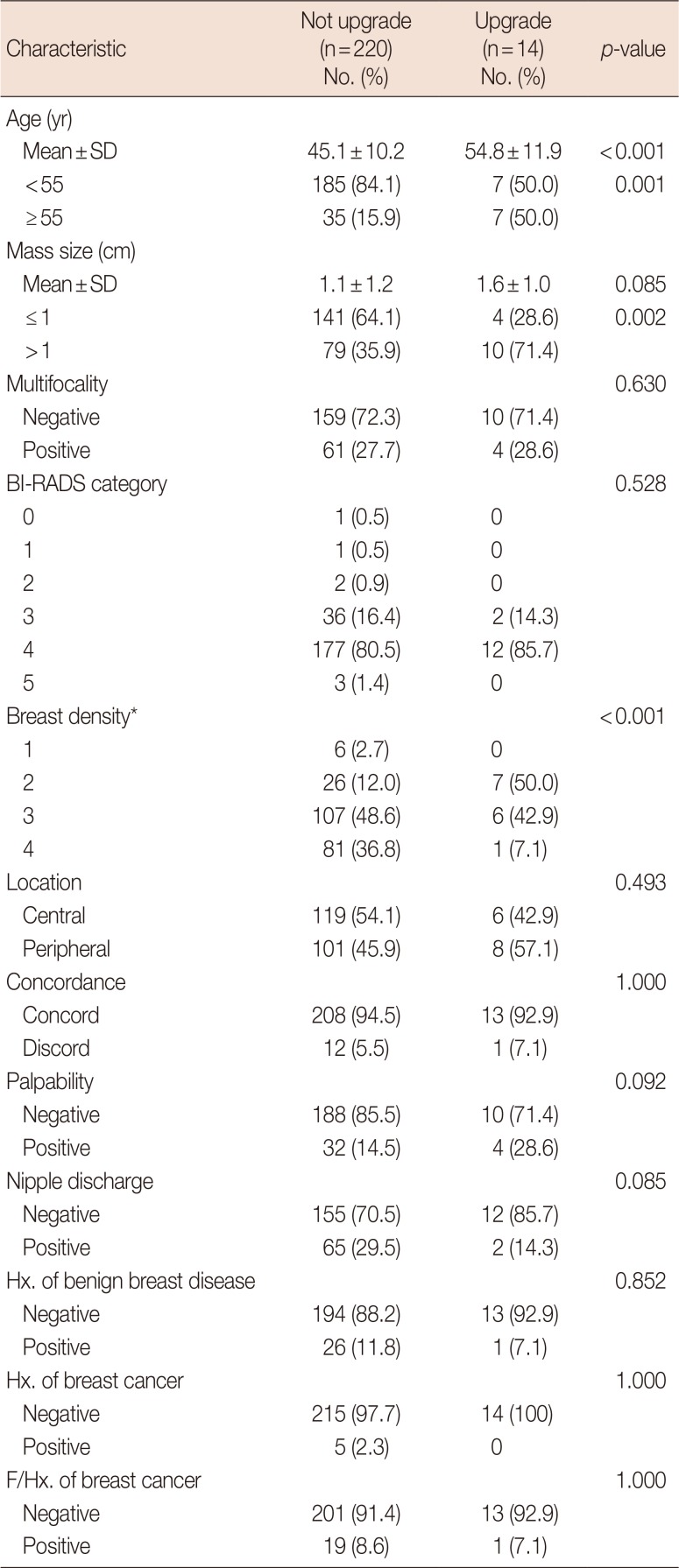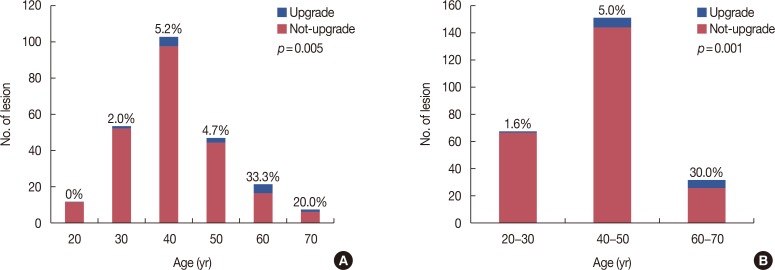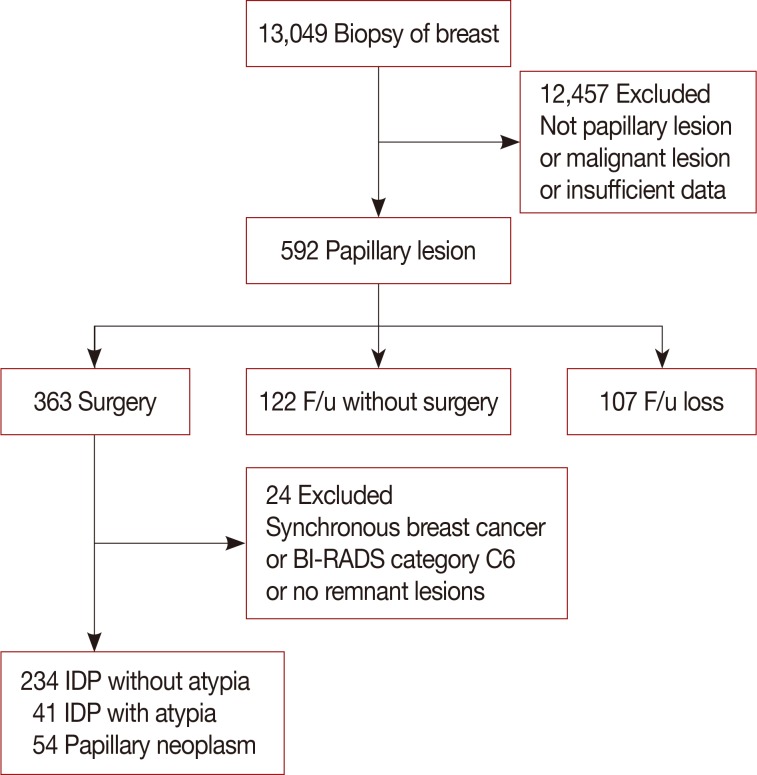1. Shamonki J, Chung A, Huynh KT, Sim MS, Kinnaird M, Giuliano A. Management of papillary lesions of the breast: can larger core needle biopsy samples identify patients who may avoid surgical excision? Ann Surg Oncol. 2013; 20:4137–4144. PMID:
23943035.

2. Nayak A, Carkaci S, Gilcrease MZ, Liu P, Middleton LP, Bassett RL Jr, et al. Benign papillomas without atypia diagnosed on core needle biopsy: experience from a single institution and proposed criteria for excision. Clin Breast Cancer. 2013; 13:439–449. PMID:
24119786.

3. Rizzo M, Linebarger J, Lowe MC, Pan L, Gabram SG, Vasquez L, et al. Management of papillary breast lesions diagnosed on core-needle biopsy: clinical pathologic and radiologic analysis of 276 cases with surgical follow-up. J Am Coll Surg. 2012; 214:280–287. PMID:
22244207.

4. Mercado CL, Hamele-Bena D, Oken SM, Singer CI, Cangiarella J. Papillary lesions of the breast at percutaneous core-needle biopsy. Radiology. 2006; 238:801–808. PMID:
16424237.

5. Skandarajah AR, Field L, Yuen Larn Mou A, Buchanan M, Evans J, Hart S, et al. Benign papilloma on core biopsy requires surgical excision. Ann Surg Oncol. 2008; 15:2272–2277. PMID:
18473143.

6. Ahmadiyeh N, Stoleru MA, Raza S, Lester SC, Golshan M. Management of intraductal papillomas of the breast: an analysis of 129 cases and their outcome. Ann Surg Oncol. 2009; 16:2264–2269. PMID:
19484312.

7. Nakhlis F, Ahmadiyeh N, Lester S, Raza S, Lotfi P, Golshan M. Papilloma on core biopsy: excision vs. observation. Ann Surg Oncol. 2015; 22:1479–1482. PMID:
25361885.

8. Renshaw AA, Derhagopian RP, Tizol-Blanco DM, Gould EW. Papillomas and atypical papillomas in breast core needle biopsy specimens: risk of carcinoma in subsequent excision. Am J Clin Pathol. 2004; 122:217–221. PMID:
15323138.
9. Jaffer S, Nagi C, Bleiweiss IJ. Excision is indicated for intraductal papilloma of the breast diagnosed on core needle biopsy. Cancer. 2009; 115:2837–2843. PMID:
19402174.

10. Yang Y, Suzuki K, Abe E, Li C, Uno M, Akiyama F, et al. The significance of combined CK5/6 and p63 immunohistochemistry in predicting the risks of subsequent carcinoma development in intraductal papilloma of the breast. Pathol Int. 2015; 65:81–88. PMID:
25572436.

11. Rakha EA. Morphogenesis of the papillary lesions of the breast: phenotypic observation. J Clin Pathol. 2016; 69:64–69. PMID:
26251523.

12. Hoshikawa S, Sano T, Hirato J, Oyama T, Fukuda T. Immunocytochemical analysis of p63 and 34betaE12 in fine needle aspiration cytology specimens for breast lesions: a potentially useful discriminatory marker between intraductal papilloma and ductal carcinoma in situ. Cytopathology. 2016; 27:108–114. PMID:
25810244.
13. Pathmanathan N, Albertini AF, Provan PJ, Milliken JS, Salisbury EL, Bilous AM, et al. Diagnostic evaluation of papillary lesions of the breast on core biopsy. Mod Pathol. 2010; 23:1021–1028. PMID:
20473278.

14. Jagmohan P, Pool FJ, Putti TC, Wong J. Papillary lesions of the breast: imaging findings and diagnostic challenges. Diagn Interv Radiol. 2013; 19:471–478. PMID:
23996839.

15. Carder PJ, Garvican J, Haigh I, Liston JC. Needle core biopsy can reliably distinguish between benign and malignant papillary lesions of the breast. Histopathology. 2005; 46:320–327. PMID:
15720418.

16. Puglisi F, Zuiani C, Bazzocchi M, Valent F, Aprile G, Pertoldi B, et al. Role of mammography, ultrasound and large core biopsy in the diagnostic evaluation of papillary breast lesions. Oncology. 2003; 65:311–315. PMID:
14707450.

17. Patel BK, Falcon S, Drukteinis J. Management of nipple discharge and the associated imaging findings. Am J Med. 2015; 128:353–360. PMID:
25447625.

18. Cheng TY, Chen CM, Lee MY, Lin KJ, Hung CF, Yang PS, et al. Risk factors associated with conversion from nonmalignant to malignant diagnosis after surgical excision of breast papillary lesions. Ann Surg Oncol. 2009; 16:3375–3379. PMID:
19641969.

19. Shiino S, Tsuda H, Yoshida M, Jimbo K, Asaga S, Hojo T, et al. Intraductal papillomas on core biopsy can be upgraded to malignancy on subsequent excisional biopsy regardless of the presence of atypical features. Pathol Int. 2015; 65:293–300. PMID:
25801805.

20. Jacobs TW, Connolly JL, Schnitt SJ. Nonmalignant lesions in breast core needle biopsies: to excise or not to excise? Am J Surg Pathol. 2002; 26:1095–1110. PMID:
12218567.
21. Loh SF, Cooper C, Selinger CI, Barnes EH, Chan C, Carmalt H, et al. Cell cycle marker expression in benign and malignant intraductal papillary lesions of the breast. J Clin Pathol. 2015; 68:187–191. PMID:
25501285.

22. Lin CH, Liu CH, Wen CH, Ko PL, Chai CY. Differential CD133 expression distinguishes malignant from benign papillary lesions of the breast. Virchows Arch. 2015; 466:177–184. PMID:
25433813.

23. Weisman PS, Sutton BJ, Siziopikou KP, Hansen N, Khan SA, Neuschler EI, et al. Non-mass-associated intraductal papillomas: is excision necessary? Hum Pathol. 2014; 45:583–588. PMID:
24444467.

24. Mosier AD, Keylock J, Smith DV. Benign papillomas diagnosed on large-gauge vacuum-assisted core needle biopsy which span <1.5 cm do not need surgical excision. Breast J. 2013; 19:611–617. PMID:
24102818.








 PDF
PDF ePub
ePub Citation
Citation Print
Print




 XML Download
XML Download